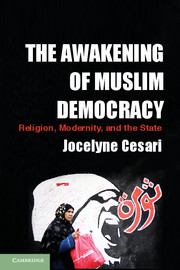Book contents
- Frontmatter
- Contents
- Acknowledgments
- Preface
- Part I THE MAKING OF ISLAM AS A MODERN RELIGION
- 1 Modernization and Politicization of Religion
- 2 Nation-State Building and the Inclusion of Muslim Polities within the Westphalian Order
- 3 Islam in the Constitution
- 4 Nationalization of Islamic Institutions and Clerics
- 5 Islam in the Legal System
- 6 Teaching Islam in Public Schools
- Part II ISLAMISM AS THE PREEMINENT POLITICAL FORCE PRE– AND POST–ARAB SPRING
- Part III THE DISJUNCTION OF DEMOCRACY AND SECULARISM – LESSONS LEARNED FROM THE ARAB SPRING
- Appendix I Religious Violence Index
- Appendix II Egyptian Constitution, Ratified on December 26, 2012. Suspended on July 3, 2013
- Bibliography
- Index
- References
6 - Teaching Islam in Public Schools
Published online by Cambridge University Press: 05 July 2014
- Frontmatter
- Contents
- Acknowledgments
- Preface
- Part I THE MAKING OF ISLAM AS A MODERN RELIGION
- 1 Modernization and Politicization of Religion
- 2 Nation-State Building and the Inclusion of Muslim Polities within the Westphalian Order
- 3 Islam in the Constitution
- 4 Nationalization of Islamic Institutions and Clerics
- 5 Islam in the Legal System
- 6 Teaching Islam in Public Schools
- Part II ISLAMISM AS THE PREEMINENT POLITICAL FORCE PRE– AND POST–ARAB SPRING
- Part III THE DISJUNCTION OF DEMOCRACY AND SECULARISM – LESSONS LEARNED FROM THE ARAB SPRING
- Appendix I Religious Violence Index
- Appendix II Egyptian Constitution, Ratified on December 26, 2012. Suspended on July 3, 2013
- Bibliography
- Index
- References
Summary
With the creation of state education systems, curricula and textbooks have socialized new generations to the idea that national identity and Islamic identity are two sides of the same coin. By inscribing Islam within the public education system, the state posits itself as the protector of Islamic heritage and assumes “the responsibility to provide children and youths with trustworthy religious guidance.”
This use of Islam in the nationalization process goes hand in hand with the exclusion or marginalization of all other religious groups. Despite attempts to focus on tolerance in religious instruction, religious minorities are neglected and discriminated against in most of the public education curricula. Additionally, because the concept of tolerance is promoted only in the context of religious instruction, other parts of the curricula (history/social studies) remain infused with Islamic terms such as jihad and continue to instill ideas of Islamic supremacy and unity against the so-called infidels.
In this regard, it is important to note that Islamic references are not limited to religious education but are incorporated throughout the entire public school curriculum. They permeate history, social studies, and civics textbooks, and even appear in mathematics. Such a “functionalization of religion,” as Gregory Starrett terms it, illustrates the socialization process at work, where the state exerts social control and assumes moral authority by promoting a “proper Islamic identity” and, by extension, the cultivation of “good social behavior” (ādāb ijtim aʿ iya) in the citizenry. For example, in Egyptian primary school textbooks, the school is portrayed as the source of the child’s moral leanings, which the child will then share with his/her family. Thus, while Egyptian textbooks focus on responsibility and duty as main Muslim values, these are virtues taught in schools and therefore primarily associated with state and public behaviors, as opposed to private virtues. Similarly in Turkey, the main objective of the Directorate of Religious Affairs is “to create ‘good citizens’ with civic responsibility toward the state.”
- Type
- Chapter
- Information
- The Awakening of Muslim DemocracyReligion, Modernity, and the State, pp. 85 - 120Publisher: Cambridge University PressPrint publication year: 2014



